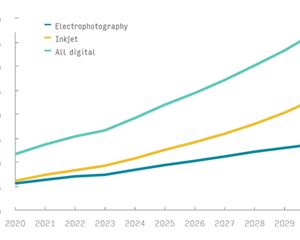Jayraj Salgaokar is the publisher and founder of Kalnirnay, India's largest selling multilingual publication. He has been a Marathi author since he started writing in 1976. He completed his post graduation in Economics from the University of Bombay in 1978. As an eclectic thinker, his interest in writing ranges from biographies, culture, economics, politics, socialand contemporary trends. In his book Neo Gutenberg, he pays tribute to the history of print through a contemporary lens.
Introduction
This is actually the story of mankind across time. Of man’s hunger for knowledge. How man gathered, organized and harnessed information to grow and evolve. The journey from stone tablets to phone tablets has been a fascinating one, a heroic adventure in time, with its own twists, turns and character. When one looks at man’s travails through time, he does appear to be a truculent creature, with a consistent record of having waged a war just about every year, over a span of at least three thousand years! Communication has come a long way since we howled like animals or scratched cave walls to express ourselves! It took an Ice Age to reach a stage wherein we could imprint our expression into clay tablets and further thousands of years before we could evolve modern phonetics. However, it was only after the evolution of phonetics that our intellectual evolution expanded at a faster pace. But the limitations faced in physical writings and literature duplication remained an impediment to the growth and fair distribution of knowledge. This would begin to change with the invention of Chinese wooden blocks and later with movable type printing which would accelerate the spread of literature.
However, the real change occurred miles across in Germany when Johannes Gutenberg through his mastery in printing made Bible easily available for masses. This innovation in printing played a decisive role in ending the dark ages and lead Europe towards Renaissance. In the last six hundred years since the occurrence of Renaissance, our civilization has experienced a measurable and faster pace of change compared to the previous generations. This isn’t a natural phenomenon, but an outcome of the spread of communication through various inventions that followed since renaissance. The evolution in communication technology gave birth to Renaissance and added impetus to civil liberty in Britan, France and later America. But it also led to the downfall of established civilization elsewhere, like India, China and America. If this progress gave us heroes like Benjamin Franklin who enriched the world with his inventions and stand on humanism, it also took a lot away from humanity in the form of Nazi Propaganda expert- Joseph Goebbels. Hence, the world gained and suffered equally since its Darwinian evolution and many critics may state that this has been a material progress sans wisdom. To which we wouldn’t disagree, as majority of the planet still lives a wretched life consumed in poverty, hunger and under totalitarian rule.
However, for a few fortunate like us who have experienced the best in technology, civil progress must work towards building a fair and free world. Unlike earlier, this would no longer be a missionary or ideological route taken by church and communists alike, this could be done by a few emails or a tweet! As since the advent of digital age and globalization, the world as we know has shrunk though it has its own inconsistencies. We the motley netizens can state that digital revolution did for us what globalization did for political leaders and tycoons. Though globalization is a recent phenomenon, digital age came in three waves: the first came with the advent of radio, home telephony and television, second with personal computers, Internet, emails, blogs and the third with the rise of social media. The rise of Obama to presidency, the fall of despots in Arab spring and the rise of countless such mutinies across the planet against an unfair order have proven the worth of social media. All these factors are changing the world for the better and by our observation these changes are equivalent to the occurrences of first renaissance.
Individuals like Mark Zuckerberg, Brin-Page duo, Jimmy Wales and Jeff Bezos today have the same influence and wealth compared to the likes of Henry Ford, Carnegie or Pulitzer did during The Industrial Age. Though at present we may not have anyone as tall as Thomas Paine, John Locke or Voltaire but we have millions of their ‘copies’ teaming up in bits and bytes across the planet striving to make their voice heard. We have followed a ‘timeline module’, following which the content of the book proceeds. This provides clarity to new readers most of whom may be young students or new readers unaware of the depths of stories within. The book aims to provide layered, interest information and analysis in sim ple object form. According to us advancement and simplification in communication technology is directly proportional to the creation of free and fair society. Hence, we shall keep on witnessing the rise netizens in the fight against tyranny who will ultimately lead to a better connected planet. Our book is a tribute to history, humanist, inventors and ‘Neo Gutenbergs’.
Chapter 1
NEOGUTENBERG
1 - Evolution of Language
 (An artistic impression of Stone Age men hunting down a woolly mammoth)
(An artistic impression of Stone Age men hunting down a woolly mammoth)
1.1 Pet Calls and Sign Language
Imagine a scenario where someone comes up to you and a start talking to you like you’re a dog or, alternatively, begins speaking to you like you’re a parrot or even a cat. Your immediate reaction would either be polite bewilderment at best or outraged offense at worst. Being spoken to like this might be taken to mean humiliation or disregard for your human stature. However, this was how it all began. Before we move ahead and understand the impact of communication and its effect on our society, we must travel back in time and understand how it evolved before societies were even formed.
It all began when humans stepped off the routine track and started behaving like no other species had done before them. Our proportionate physical build and evolved brain allowed us to communicate and progress in a way that has made a lot of what we see now possible. Today, we consider ourselves a superior species. However, this wasn’t always the case. At that time, if you would have been brave (and foolhardy) enough to challenge a dinosaur, a whale or even a grizzly bear for a one-on-one fight; you would have definitely found yourself in a heap of trouble. Yet, today we find only skeletal remains of dinosaurs, whale meat in the Japanese market and the bear dancing to our tunes. Largely thanks to our mental development, we humans find ourselves ruling the roost.
Humankind arrived on the scene after most other living species had already been around for several million years (and long after the dinosaurs became extinct). Despite its late arrival, humankind has emerged superior to all other existing and extinct living beings on earth. One of the prime reasons for this accomplishment was the evolution of our ability to communicate effectively. What began with niche exchanges of symbols, sounds, gestures and body language; eventually led to the information explosion we see today. (02)
Eventually, these exchanges were found to be inadequate to cope with our daily communication needs. Consequently, we started capturing what we saw in our surroundings through drawings and carvings on the walls of caves and other surfaces around us.
(01) In the earliest known Paleolithic era, humans started recognizing the existence of similar species around them. It was around this time that man attempted to communicate with his counterparts and, in due course, came together to form habitable clusters. Man observed that creatures around him used sound to communicate with each other. Inspired by this novel method of exchanging information, he began to develop communication patterns. It can be estimated that human beings started communicating amongst themselves during the Stone Age, approximately 30,000 years ago. (01)
The next step was for humans to come together and use these patterns of communication so they could hunt in groups. Possessing minimal (and in many cases) no weaponry, humans stood scant chance of hunting all by their individual selves.The harshness of the terrain and the agility of the animals also served as additional deterrents. Hence, to have an edge over the circumstances, humans decided to use vocal signals to coordinate with each other for the hunt. Experts who study language and prehistoric ways of life think that approximately around 3000 BC, man began to replicate sounds such as the barking of certain animals and the howling of the wind. Pet calls, as they are now called, were the only means of communication for the Stone Age man. This was effective during the initial stages when the hunters were few and the need for communication was basic. However, as their numbers grew, these hunting terrain pet calls could not cope with the needs of a larger group and a complex hunt. Uncoordinated pet calls would reveal the position of the hunter to the animals often resulting either in a hunter’s death or the animal escaping his clutches. It now became imperative to supplement pet calls with an inaudible process of communication. Man’s need to resolve this limitation in the process of exchanging information with those around him led to the development of sign language. The conditions surrounding early humans also impacted the mode of language they chose to employ. For instance, if they were hunting in areas featuring high grass, verbal signals were preferred; on open plains they would rather use signs to communicate with each other to prevent the animals from becoming alert.
Sign Language
Sign language originated in the prehistoric times. Unlike pet calls and many other now defunct communicative habits, sign language still exists as a formal mode of communication. This form has evolved over the centuries and is now largely used by the deaf/verbally impaired, by security/military personnel and by drivers on the road. There is a difference between instinctive gestures like the times you point the way when you are explaining directions to someone and deliberate gestures such as those involving numerical calculations. (04, 01)
But which originated first - sign language or vocal language?
This debate is the chicken-and-egg dilemma in the linguistic field. The exact origins of sign language are still cloaked in mystery. Some experts are convinced that gestures preceded vo cal utterance in human communication. There are others who believe otherwise. While some are of the opinion that there was not any orderly development at all. There is some scientific evidence to support the claim that humans used gestures before they began speaking. Paleontologists who studied the bones of hominids (humans and relatives of humans closer than chimpanzees) have suggested that the vocal cords of early humans would not have been able to accommodate the complex speech apparatus we now have. According to Dr. Jerome D. Schein, once the hominids became erect, their hands were freed—to use tools as well as to communicate. Consequently, anthropologists regard the period when the Homo erectus evolved as a possible date for the beginning of sign language. This can be traced back to about a hundred thousand years. However, these facts are hard to corroborate due to lack of concrete evidence. These evolutionary patterns also clash with those which are not included in the Darwinian Theory.

(courtesy Pg 44, The Printing Revolution in Early Modern Europe ,By Elizabeth L. Eisenstein)
1.2 Cave Paintings and Rock Carvings
(30,000 year old spotted hyena painting found in the Chauvet Cave - France)
Experts can be left to decide whether man’s first language was primarily gestural or whether it involved vocal sounds. However, what we know for certain is that communication and expression of thought went unrecorded for a long time, right until man realized the need to document what he saw and felt. Today, the art of painting is not a Herculean task with all the tools we have at our convenient disposal. But early man’s cave paintings evoke a sense of respect, particularly considering his mental faculty and the implements he had at hand. Objective painting per se is the ability to imagine and record what you see through deftly applied strokes in a defined symmetry. It took mankind many years to reach this stage. In the process our ancestors started painting on the walls and ceilings of the caves that sheltered them with easily available objects like charcoal, soot and twigs. This antiquity forms the most visible and well-preserved form of prehistoric recordings.
The earliest known art presently available to us constitutes the European cave paintings from the Aurignacan culture (during the Upper Paleolithic era in Europe and Southwest Asia) dating back to approximately 40,000 years ago. (02) The exact purpose of the Paleolithic cave paintings is not known. Since the caves show no signs of extended habitation, experts suggest that these paintings were not used to merely decorate their habitats. Some theories propose that these cave paintings may have been a way of communicating with others; other theories ascribe them religious or ceremonial significance. Religion as a reason seems suspect since it was yet to evolve.
During that time, humans were primarily nomadic hunters, constantly shifting base to areas with larger concentrations of animals. One assumes that since their cave paintings were not portable, they had to be left behind. Constantly having to leave behind something they had spent so much time and effort on and that carried memories of the past created a sort of mental emptiness. This uneasy feeling forced man to create portable objects capable of holding memories which he could actually carry along with him once he left, sort of like a prehistoric flash drive. (01, 02)
Thus humans started carving things that were portable, such as pieces of wood and stone. Archaeologists called these objects petroglyphs. Petroglyphs are images engraved in rock, usually by prehistoric, particularly Neolithic people. (04) They were an important form of symbol-based communication and acted as a predecessor to writing systems. The oldest petroglyphs are dated to approximately 10,000 to 12,000 years ago. (01)They have been found in all parts of the globe except Antarctica with highest concentrations in parts of Africa, Scandinavia, Siberia, Southwestern North America and Australia.
However, petroglyphs were around even after other writing systems rendered them obsolete; some lesser advanced societies continued using them for a much longer time, even until they made contact with Western culture in the 20th century. The amalgamation of historic and modern cultures kept happening till the mid-1950s through the remote tribes in Brazil, Africa, Borneo and Australia. It’s important that we mention this here as, when we speak of mankind, we include everyone in the definition and not only the select few who made their mark through social and economic development. At the moment, we are clashing with these tribes and perhaps destroying their way of life; the way of life which is the only living record of our existence in prehistoric times.
These engraved images probably had deep cultural and religious significance for the societies that created them; in many cases this significance remains for their descendants. Many petroglyphs are thought to represent some kind of symbolic or ritualistic language. Some researchers have noticed that petroglyphs across different continents resemble each other. While one expects all people to be inspired by their surroundings, it is harder to explain the prevalence of the extremely similar styles. Native indigenous thinkers and spiritualists would be thrilled to be confronted with such mysterious universal bonding in expression; perhaps some aspects cannot be explained by logic or empirical form. A variation of this belief forms a crucial part of many present cultures that choose to ascribe significance to certain objects, considering them to be superstitious or just plain lucky. However, this could all just be a mere coincidence. It might simply indicate a common origin where certain groups of people migrated widely from an initial common area.
1.3 Pictographs and Ideograms
(A petroglyph of a caravan of bighorn sheep near Moab, Utah)
Homo sapiens took about 20,000 years to move from painting on caves to engraving everyday objects. By this time man had started expanding his food sources beyond hunting by cultivating land in small patches. The Agrarian Age caused nomads to stop wandering in search of food and created planned communities across water bodies throughout the planet. However, the ascent of civilization brought forth its own challenges. Humans had neither an established language nor proper communication techniques. They possibly used other forms of communication, often as memory aids, such as specially arranged stones, symbols carved in wood or earth, ropes made from naturally occurring plant fibres and tattoos. However, apart from the durable carved stones, little else has survived into modern times. We can only hazard a guess about their existence based on our observations of existing hunter-gatherer cultures such as those that have survived in Africa and Oceania. By this time humans had reached a stage of developing their methods of communication. Man started linking things using symbols around 5000 BC. In this form, his pictures not only portrayed what he saw but went beyond that to depict the ideas he wanted to convey. This system was unlike cave paintings which were plain images. Experts believe that pictographs emerged after petroglyphs and still remain in existence. (01)
Ancient Chinese, Sumerian and Egyptian civilizations began to use such symbols over 5000 years ago, developing them into logographic writing systems around the third millennium BC. Some non-literate cultures in Africa, the Americas and Oceania still use pictographs as their main medium of written communication. Most contemporary cultures largely use pictographs as simple, pictorial, representational symbols. Pictographs can often transcend languages. They can act as an efficient means of communication between speakers of diverse dialects and language families, even if the languages and cultures themselves are completely different. For example, pictograms representing “No Smoking”, “Danger” and “Radioactive Hazard” are familiar the world over. That’s the reason pictographic elements like road signs are nearly identical; they’re often applied as global standards because it’s assumed that everyone understands them. (01,02)
The discovery that pictograms were not enough to fulfill the communication needs of a community caused their improvisation. This led to the development of ideograms. An ideogram or ideograph refers to a system of communication where an idea is represented by a graphical symbol rather than by a group of letters arranged according to the phonemes of a spoken language. Some ideograms can only be understood if one is familiar with prior definitions; others convey their meaning through their graphic resemblance to a physical object. Ideographic elements are found in the writing systems that developed in the Near East (the Sumerians, Babylonians, Assyrians, Hittites and Egyptians) during the Bronze Age - approximately between 2500 BC and the first century BC. Arabic numerals and mathematical notations are full of ideograms; they are used all over the world, regardless of how they’re pronounced in different languages. The ancient Chinese text can be considered to be a mutant form of ideographic and written form. (01, 03)
(Self -explanatory pun-oriented pictogram)
In his book The Information, James Gleick delves into the intricacies of the language:
“Chinese unifies an array of distinct spoken languages:
people who cannot speak to one another can write to one another. It employs at least fifty thousand symbols, about six thousand commonly used and known to most literate Chinese. In swift diagrammatic strokes they encode multidimensional semantic relationships. One device is simple repition: tree + tree + tree = forest; more abstractly, sun + moon = brightness and east + east = everywhere. The process of compounding creates surprises: grain + knife = profit; hand + eye = look… Some elements are phonetic; some even punning. The entirety is the richest and most complex writing system that humanity has ever evolved.”
No wonder it’s so difficult to learn Chinese!
1.4 Cuneiform Scripts and Palm Leaf Writings
(Sumerian inscription in monumental archaic style, circa 26th century BC)
James Gleick’s The Information explains cuneiform thusly:
“First there were scores, then thousands of tablets, typically the size of a human hand, etched with a distinctive, edgy, angular writing called cuneiform, ‘wedge shaped’. Mature cuneiform was neither pictographic (the symbols were spare and abstract) nor alphabetic (they were far too numerous). The materials for this most ancient of information technologies lay readily at hand. With damp clay held in one hand and a stylus of sharpened reed in the other, a scribe would imprint tiny characters in columns and rows. The result: cryptic messages from an alien culture. They took generations to decipher.”
The technique was widely used as a form of writing. Most of the writing systems from this era combine ideographic elements with other principles, including some symbols that represented speech sounds called phonograms. This was true of the best known such system, the Egyptian hieroglyphics. The conception of the first writing system roughly coincides with the beginning of the Bronze Age in the late Neolithic era, around the late fourth millennium BC. Prehistoric Sumer is generally believed to have birthed the first writing system; by the late third millennium, it developed into cuneiform. Hieroglyphs of the Egyptians, the Proto-Elamite writing system and the Indus Valley scripts also approximately date to this era. The cuneiform writing technique became a general purpose writing system for logograms, syllables, and numbers. (01) The third millennium saw the expansion of the cuneiform script. The pictorial representations became simple and more abstract; the number of characters that were used gradually grew smaller, from about 1000 unique characters in the Early Bronze Age to about 400 in the Late Bronze Age. Languages such as Akkadian, Eblaite, Elamite, Hittite, Luwian, Hattic, Hurrian and Urartian were extensively inspired from the cuneiform. (01, 03) It also greatly inspired the Ugaritic and Old Persian alphabets. But this cuneiform script was gradually replaced by the Phoenician alphabet and soon became extinct.
The scripts which developed before and during this era were written on materials which could not be preserved for too long; thus the successive generations had a tough time trying to decipher those scripts. Man resorted to using the naturally available leaves around him to write his scripts; these leaves served the purpose of preserving the writings for others to read. These palm leaf manuscripts were usually made out of dried palm leaves. It is one of the oldest mediums of writing in South and Southeast Asian countries. They were used to record events, mythical narratives as well as paintings. Traditionally, information was passed down orally; this changed after the alphabet was invented and started gaining popularity in South Asia. People began using palm leaves to preserve and share their knowledge. Two of the most widely used leaves came from the palmyra palm and the talipot palm. Leaves were dried and treated before being written upon. Writing on palm leaves wasn’t an easy task; only a section of people were trained in this skill. The average lifespan of a palm leaf manuscript was about 300-350 years. Whenever a manuscript decayed, its contents were transferred to a new set of leaves. Nations like India, Sri Lanka, Nepal, Burma, Indonesia, Thailand and Cambodia are home to collections of palm leaf documents. The ageof the ancient scripts ended with the palm leaves. (01, 02)
 {Copy of Indian palm leaf manuscript of 'Thol.kaa.p.pi.am' (500 BC)}
{Copy of Indian palm leaf manuscript of 'Thol.kaa.p.pi.am' (500 BC)}

Click here to access a complete list of chapters from Neo Gutenberg by Jayraj Salgaokar and Amit Chatterjee
OR
log on to www.printweek.in/NeoGutenberg





















 See All
See All